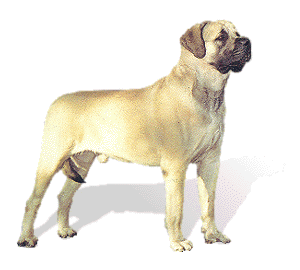English Mastiff Breed Information

Description
The Old English Mastiff is one of the heaviest breeds; a male Mastiff can exceed 200 pounds. This dog is very massive, powerful and muscular. The head is heavy and square with a short muzzle. There is a black mask around the eyes and nose no matter what the general coat color. The eyes are small, dark, and hazel. The small ears should also be dark-colored. The teeth should meet in a scissors or slightly undershot bite. The tail is set quite high, tapers to the tip, and reaches to the hocks. The short coat comes in golden fawn, light fawn, brindle, silver, tiger, and apricot and is easy to groom. In the eighteenth century it was described as follows: “As a lion is to a cat, so is a mastiff compared to a dog.”
Temperament
Originally valued for their abilities as a fierce guard and fighting dog, today’s Mastiff is a gentle giant. It is a self-confident, watchful, and patient dog who is gentle-natured towards his family. Intelligent and dignified. It rarely barks, but it is in its nature to defend its territory and family. Calm, steady and docile, this dog is normally excellent with children, (not recommend for toddlers though, because of their great size). Good natured, but very large and heavy. Responds well to gentle, patient training. This breed loves to please and needs lots of companionship. The Mastiff’s dominance varies widely depending on the lineage. They can be aloof with strangers or fairly friendly. Do not hit a Mastiff or you are asking for it! A born guard dog, brave and loyal. When strangers visit, it is likely to refuse to let them in unless they are accepted by its handler. The Mastiff generally holds intruders at bay rather than attacking. Protection training is unnecessary for this naturally protective breed. It is very possessive of home, family and car. It may be combative with other dogs if not very well socialized as a puppy, so extra effort should be given to socialize a Mastiff puppy. If properly socialized it will get along well with other dogs. The Mastiff tends to drool, wheeze and snore loudly. They can be somewhat difficult to train.
Height, Weight
Height: Dogs from 30 inches (76cm) Bitches from 27 inches (69cm)
Weight: Dogs about 160 pounds (72kg) Bitches about 150 pounds (68kg)
Health Problems
Beware of hip dysplasia. As these dogs are prone to bloat, feed two or three small meals a day, instead of one large one. Also prone to CHD, gastric torsion, ectropion, PPM, vaginal hyperplasia, elbow dysplasia and PRA. Occasionally seen is cardiomyopathy.
Living Conditions
The Mastiff will do okay in an apartment if it is sufficiently exercised. They are relatively inactive indoors and a small yard will do.
Exercise
Mastiffs are inclined to be lazy but they will keep fitter and happier if given regular exercise. They should always be leashed in public.
Life Expectancy
About 10-12 years.
Grooming
The smooth, short-haired coat is easy to groom. Brush with a firm bristle brush and wipe over with a piece of toweling or chamois for a gleaming finish. Bathe or dry shampoo when necessary. This breed is an average shedder.
Origin
Found in Britain as early as the Roman invasion, the Noble Old English Mastiff was probably brought to that island by Phoenician traders as early as the 6th century BC. Since then, the Mastiff has been used as an arena gladiator by the Romans, in the bloody sport of bull, bear and dog combat, and as a sheep guardian, bodyguard, protector, and companion. A Mastiff came to America on the Mayflower and subsequently other dogs were imported. By the end of World War II, Mastiffs were almost extinct in England. However, with fresh imports from the United States and Canada, the breed is once again well established in today’s England. Some of the Mastiff’s talents include: watchdogging, guarding, police work, military work, search & rescue, and weight pulling.
Group
Mastiff, AKC Working
Recognition
CKC, FCI, AKC, UKC, KCGB, CKC, ANKC, NKC, NZKC, APRI, ACR
